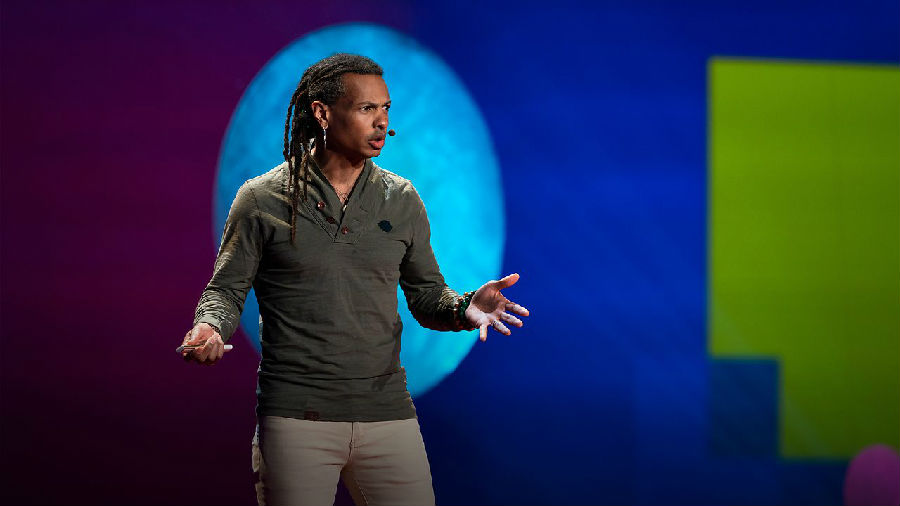(单词翻译:单击)
I am an astrodynamicist -- you know, like that guy Rich Purnell in the movie "The Martian."
我是一个天体力学家,就像《火星救援》里的瑞奇·珀内尔。
And it's my job to study and predict motion of objects in space.
而我的工作就是研究并预测太空中物体的运动轨迹。
Currently we track about one percent of hazardous objects on orbit
当前我们正在追踪轨道上大约百分之一的危险物体,
hazardous to services like location, agriculture, banking, television and communications,
那些比如威胁到定位服务、农业、银行业、通信与电话业、
and soon -- very soon -- even the internet itself.
并且很快--比你想的要快,会威胁到互联网本身的物体。
Now these services are not protected from, roughly, half a million objects the size of a speck of paint all the way to a school bus in size.
目前这些服务设施暴露在大约50万从一粒油漆直到校车大小物体的威胁中。
A speck of paint, traveling at the right speed, impacting one of these objects, could render it absolutely useless.
一点油漆以适当的速度运行时,撞击其中一个设备,可能让它彻底报废。
But we can't track things as small as a speck of paint.
但我们无法跟踪像一块油漆那么小的东西。
We can only track things as small as say, a smartphone.
我们只能跟踪到小至,比如说智能手机那样的东西。
So of this half million objects that we should be concerned about, we can only track about 26,000 of these objects.
所以在这50万我们应该关心的物体中,我们只能跟踪其中的26000个。
And of these 26,000, only 2,000 actually work. Everything else is garbage. That's a lot of garbage.
而这26000个中,只有2000个真正有用。其他都是垃圾。有很多的垃圾。
To make things a little bit worse, most of what we launch into orbit never comes back.
让事情变得更糟糕的是,我们发射到轨道的大部分物体永远不会返回。
We send the satellite in orbit, it stops working, it runs out of fuel,
我们把卫星发射到轨道,它停止了工作,燃料用尽,
and we send something else up ... and then we send up something else ... and then something else.
然后我们发射其他的上去...接着又发射其他的上去...一波接一波。
And every once in a while, two of these things will collide with each other or one of these things will explode,
每隔一段时间,其中两个物体会相互碰撞或者其中一个物体会爆炸,
or even worse, somebody might just happen to destroy one of their satellites on orbit,
或者更糟糕,有人可能恰好在轨道摧毁他们的一颗卫星,
and this generates many, many more pieces, most of which also never come back.
这产生了更多的碎片,很多碎片再也不会回到地球。
Now these things are not just randomly scattered in orbit.
如今这些物体不仅只是随机散落在轨道。
It turns out that given the curvature of space-time,
实际上,给定时空的曲率,
there are ideal locations where we put some of these satellites -- think of these as space highways.
存在一些理想的位置可以放置一些卫星--可以把这些位置想象成太空高速公路。
Very much like highways on earth, these space highways can only take up a maximum capacity of traffic to sustain space-safe operations.
非常像地球上的高速公路,这些太空高速公路只能占用最大的运输能力来维持空间的安全运作。
Unlike highways on earth, there are actually no space traffic rules.
不像地球上的高速公路,这里事实上没有太空交通规则。
None whatsoever, OK? Wow. What could possibly go wrong with that?
一点儿也没有。喔。这能有什么问题呢?

Now, what would be really nice is if we had something like a space traffic map,
如果我们有像太空交通地图那样的东西会很棒,
like a Waze for space that I could look up and see what the current traffic conditions are in space, maybe even predict these.
比如Waze太空地图可以让我看到太空的交通状况,甚至能进行预测。
The problem with that, however, is that ask five different people, "What's going on in orbit? Where are things going?"
但问题在于,问5个不同的人,“轨道现在怎样了?这些物体去哪了?”
and you're probably going to get 10 different answers.
你可能会得到10个不同的答案。
Why is that? It's because information about things on orbit is not commonly shared either.
为什么会那样?因为轨道上物体的信息并没有充分共享。
So what if we had a globally accessible, open and transparent space traffic information system
那么,如果我们有一个全球可访问的、开放和透明的空间交通信息系统,
that can inform the public of where everything is located to try to keep space safe and sustainable?
可以告知公众物体的位置,以保证太空安全和可持续会怎样呢?
And what if the system could be used to form evidence-based norms of behavior -- these space traffic rules?
如果这个系统可以用来形成以证据为基础的行为规范--这些太空交通规则,会怎样呢?
So I developed ASTRIAGraph, the world's first crowdsourced, space traffic monitoring system at the University of Texas at Austin.
所以我开发了ASTRIAGraph,在德克萨斯大学奥斯汀分校诞生的世界首个众包的太空交通监控系统。
ASTRIAGraph combines multiple sources of information from around the globe -- government, industry and academia
ASTRIAGraph结合了来自全球各地的信息源--政府部门,工业界和学术界,
and represents this in a common framework that anybody can access today.
并用今天任何人都可以访问的公共框架进行展示。
Here, you can see 26,000 objects orbiting the earth, multiple opinions, and it gets updated in near real time.
在这里,你可以看到有26000个绕地球运行的物体,来自不同的角度,并以接近实时的速度更新。
But back to my problem of space traffic map: What if you only had information from the US government?
但回到我的空间交通地图问题:如果你只有美国政府的信息会怎样?
Well, in that case, that's what your space traffic map would look like.
在这种情况下,这是你的太空交通地图的样子。
But what do the Russians think? That looks significantly different.
但俄罗斯人会怎么想?这看起来就明显不同。
Who's right? Who's wrong? What should I believe? What could I trust? This is part of the issue.
谁是对的?谁是错的?我应该相信什么?我应该信任谁?这是一部分问题。
In the absence of this framework to monitor space-actor behavior, to monitor activity in space
缺乏这个框架来监控太空物体行为,去监控太空活动,
where these objects are located -- to reconcile these inconsistencies and make this knowledge commonplace,
这些设备的位置--去调和这些矛盾和让这些知识变得司空见惯,
we actually risk losing the ability to use space for humanity's benefit. Thank you very much.
我们其实是冒着失去太空用于人类福祉的风险。谢谢大家。


